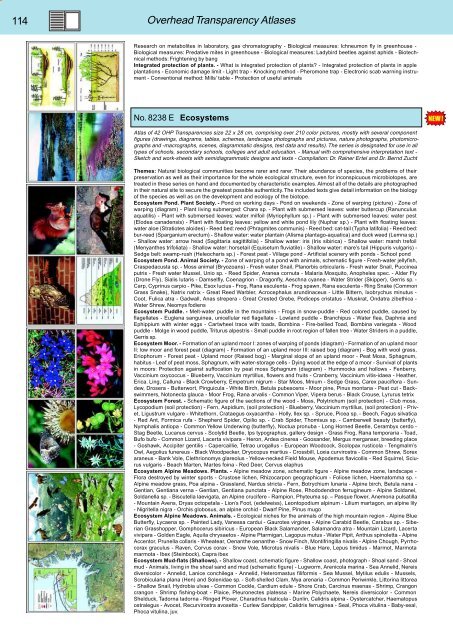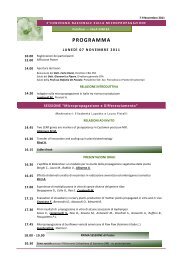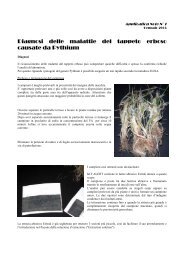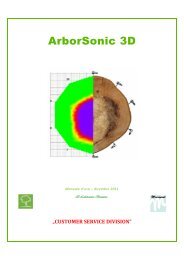BIOLOGY - microscopia.info
BIOLOGY - microscopia.info
BIOLOGY - microscopia.info
Create successful ePaper yourself
Turn your PDF publications into a flip-book with our unique Google optimized e-Paper software.
114<br />
Overhead Transparency Atlases<br />
Research on metabolites in laboratory, gas chromatography - Biological measures: Ichneumon fly in greenhouse -<br />
Biological measures: Predative mites in greenhouse - Biological measures: Ladybird beetles against aphids - Biotechnical<br />
methods: Frightening by bang<br />
Integrated protection of plants. - What is integrated protection of plants? - Integrated protection of plants in apple<br />
plantations - Economic damage limit - Light trap - Knocking method - Pheromone trap - Electronic scab warning instrument<br />
- Conventional method: Mills’ table - Protection of useful animals<br />
No. 8238 E Ecosystems<br />
Atlas of 42 OHP Transparencies size 22 x 28 cm, comprising over 210 color pictures, mostly with several component<br />
figures (drawings, diagrams, tables, schemes, landscape photographs and pictures, nature photographs, photomicrographs<br />
and -macrographs, scenes, diagrammatic designs, test data and results). The series is designated for use in all<br />
types of schools, secondary schools, colleges and adult education. - Manual with comprehensive interpretation text -<br />
Sketch and work-sheets with semidiagrammatic designs and texts - Compilation: Dr. Rainer Ertel and Dr. Bernd Zucht<br />
Themes: Natural biological communities become rarer and rarer. Their abundance of species, the problems of their<br />
preservation as well as their importance for the whole ecological structure, even for inconspicuous microbiotopes, are<br />
treated in these series on hand and documented by characteristic examples. Almost all of the details are photographed<br />
in their natural site to secure the greatest possible authenticity. The included texts give detail <strong>info</strong>rmation on the biology<br />
of the species as well as on the development and ecology of the biotope.<br />
Ecosystem Pond. Plant Society. - Pond on working days - Pond on weekends - Zone of warping (picture) - Zone of<br />
warping (diagram) - Plant living submerged: Chara sp. - Plant with submersed leaves: water buttercup (Ranunculus<br />
aquatilis) - Plant with submersed leaves: water milfoil (Myriophyllum sp.) - Plant with submersed leaves: water pest<br />
(Elodea canadensis) - Plant with floating leaves: yellow and white pond lily (Nuphar sp.) - Plant with floating leaves:<br />
water aloe (Stratiotes aloides) - Reed bed: reed (Phragmites communis) - Reed bed: cat-tail (Typha latifolia) - Reed bed:<br />
bur-reed (Sparganium erectum) - Shallow water: water plantain (Alisma plantago-aquatica) and duck weed (Lemna sp.)<br />
- Shallow water: arrow head (Sagittaria sagittifolia) - Shallow water: iris (Iris sibirica) - Shallow water: marsh trefoil<br />
(Menyanthes trifoliata) - Shallow water: horsetail (Equisetum fluviatile) - Shallow water: mare’s tail (Hippuris vulgaris) -<br />
Sedge belt: swamp-rush (Heleocharis sp.) - Forest peat - Village pond - Artificial scenery with ponds - School pond<br />
Ecosystem Pond. Animal Society. - Zone of warping of a pond with animals, schematic figure - Fresh-water jellyfish,<br />
Craspedacusta sp. - Moss animal (Bryozoans) - Fresh water Snail, Planorbis orbicularis - Fresh water Snail, Puccinea<br />
putris - Fresh water Mussel, Unio sp. - Reed Spider, Aranea cornuta - Malaria Mosquito, Anopheles spec. - Alder Fly<br />
(Drone Fly), Sialis lutaris - Damselfly, Coenagrion - Dragonfly, Aeschna cyanea - Water Strider (Skipper), Gerris sp. -<br />
Carp, Cyprinus carpio - Pike, Esox lucius - Frog, Rana esculenta - Frog spawn, Rana esculenta - Ring Snake (Common<br />
Grass Snake), Natrix natrix - Great Reed Warbler, Acrocephalus arundinaceus - Little Bittern, Ixobrychus minutus -<br />
Coot, Fulica atra - Gadwall, Anas strepera - Great Crested Grebe, Podiceps cristatus - Muskrat, Ondatra zibethica -<br />
Water Shrew, Neomys fodiens<br />
Ecosystem Puddle. - Melt-water puddle in the mountains - Frogs in snow-puddle - Red colored puddle, caused by<br />
flagellates - Euglena sanguinea, unicellular red flagellate - Lowland puddle - Branchipus - Water flea, Daphnia and<br />
Ephippium with winter eggs - Cartwheel trace with toads, Bombina - Fire-bellied Toad, Bombina variegata - Wood<br />
puddle - Molge in wood puddle, Triturus alpestris - Small puddle in root region of fallen tree - Water Striders in a puddle,<br />
Gerris sp.<br />
Ecosystem Moor. - Formation of an upland moor I: zones of warping of ponds (diagram) - Formation of an upland moor<br />
II: low moor and forest peat (diagram) - Formation of an upland moor III: raised bog (diagram) - Bog with wool grass,<br />
Eriophorum - Forest peat - Upland moor (Raised bog) - Marginal slope of an upland moor - Peat Moss, Sphagnum,<br />
habitus - Leaf of peat moss, Sphagnum, with water-storage cells - Dying wood at the edge of a moor - Survival of plants<br />
in moors: Protection against suffocation by peat moss Sphagnum (diagram) - Hummocks and hollows - Fenberry,<br />
Vaccinium oxycoccus - Blueberry, Vaccinium myrtillus, flowers and fruits - Cranberry, Vaccinium vitis-idaea - Heather,<br />
Erica. Ling, Calluna - Black Crowberry, Empetrum nigrum - Star Moos, Mnium - Sedge Grass, Carex pauciflora - Sundew,<br />
Drosera - Butterwort, Pinguicula - White Birch, Betula pubescens - Moor pine, Pinus montana - Peat cut - Backswimmers,<br />
Notonecta glauca - Moor Frog, Rana arvalis - Common Viper, Vipera berus - Black Crouse, Lyrurus tetrix<br />
Ecosystem Forest. - Schematic figure of the sections of the wood - Moss, Polytrichum (soil protection) - Club moss,<br />
Lycopodium (soil protection) - Fern, Aspidium, (soil protection) - Blueberry, Vaccinium myrtillus, (soil protection) - Privet,<br />
Ligustrum vulgare - Whitethorn, Crataegus oxyacantha - Holly, Ilex sp. - Spruce, Picea sp. - Beech, Fagus silvatica<br />
- Red Ant, Formica rufa - Shepherd Spider, Opilio sp. - Crab Spider, Thomisus sp. - Camberwell beauty (butterfly),<br />
Nymphalis antiopa - Common Yellow Underwing (butterfly), Noctua pronuba - Long Horned Beetle, Cerambyx cerdo -<br />
Stag Beetle, Lucanus cervus - Scolytid Beetle, Ips typographus, gallery design - Grass Frog, Rana temporaria - Toad,<br />
Bufo bufo - Common Lizard, Lacerta vivipara - Heron, Ardea cinerea - Goosander, Mergus merganser, breeding place<br />
- Goshawk, Accipiter gentilis - Capercaillie, Tetrao urogallus - European Woodcock, Scolopax rusticola - Tengmalm’s<br />
Owl, Aegolius funereus - Black Woodpecker, Dryocopus martius - Crossbill, Loxia curvirostra - Common Shrew, Sorex<br />
araneus - Bank Vole, Clethrionomys glareolus - Yellow-necked Field Mouse, Apodemus flavicollis - Red Squirrel, Sciurus<br />
vulgaris - Beach Marten, Martes foina - Red Deer, Cervus elaphus<br />
Ecosystem Alpine Meadows. Plants. - Alpine meadow zone, schematic figure - Alpine meadow zone, landscape -<br />
Flora destroyed by winter sports - Crustose lichen, Rhizocarpon geographicum - Foliose lichen, Haematomma sp. -<br />
Alpine meadow grass, Poa alpina - Grassland, Nardus stricta - Fern, Botrychium lunaria - Alpine birch, Betula nana -<br />
Gentian, Gentiana verna - Gentian, Gentiana punctata - Alpine Rose, Rhododendron ferrugineum - Alpine Soldanel,<br />
Soldanella sp. - Biscutella laevigata, an Alpine crucifere - Rampion, Phyteuma sp. – Pasque flower, Anemona pulsatilla<br />
- Mountain Avens, Dryas octopetala - Lion’s Foot, (edelweiss), Leontopodium alpinum - Lilium martagon, an alpine lily<br />
- Nigritella nigra - Orchis globosus, an alpine orchid - Dwarf Pine, Pinus mugo<br />
Ecosystem Alpine Meadows. Animals. - Ecological niches for the animals of the high mountain region - Alpine Blue<br />
Butterfly, Lycaena sp. - Painted Lady, Vanessa cardui - Gaurotes virginea - Alpine Carabid Beetle, Carabus sp. - Siberian<br />
Grasshopper, Gomphocerus sibiricus - European Black Salamander, Salamandra atra - Mountain Lizard, Lacerta<br />
vivipara - Golden Eagle, Aquila chrysaetos - Alpine Ptarmigan, Lagopus mutus - Water Pipit, Anthus spinoletta - Alpine<br />
Accentor, Prunella collaris - Wheatear, Oenanthe oenanthe - Snow Finch, Montifringilla nivalis - Alpine Chough, Pyrrhocorax<br />
graculus - Raven, Corvus corax - Snow Vole, Microtus nivalis - Blue Hare, Lepus timidus - Marmot, Marmota<br />
marmota - Ibex (Steinbock), Capra ibex<br />
Ecosystem Mud-flats (Shallows). - Shallow coast, schematic figure - Shallow coast, photograph - Shoal sand - Shoal<br />
mud - Animals, living in the shoal sand and mud (schematic figure) - Lugworm, Arenicola marina - Sea Annelid, Nereis<br />
diversicolor - Annelid, Lanice conchilega - Annelid, Heteromastus filiformis - Sea Mussel, Mytilus edulis - Mussels,<br />
Scrobicularia plana (Hen) and Solenidae sp. - Soft-shelled Clam, Mya arenaria - Common Periwinkle, Littorina littorea<br />
- Shallow Snail, Hydrobia ulvae - Common Cockle, Cardium edule - Shore Crab, Carcinus maenas - Shrimp, Crangon<br />
crangon - Shrimp fishing-boat - Plaice, Pleuronectes platessa - Marine Polychaete, Nereis diversicolor - Common<br />
Shelduck, Tadorna tadorna - Ringed Plover, Charadrius hiaticula - Dunlin, Calidris alpina - Oystercatcher, Haematopus<br />
ostralegus - Avocet, Recurvirostra avosetta - Curlew Sandpiper, Calidris ferruginea - Seal, Phoca vitulina - Baby-seal,<br />
Phoca vitulina, juv.







